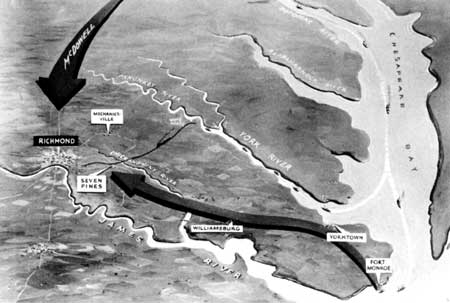|
RICHMOND National Battlefield Park |
 |
PART ONE
THE PENINSULA CAMPAIGN, SUMMER, 1862

McClellan's plan of attack.
Painting by Sidney King.
On To Richmond
Instead of marching overland, McClellan decided to take advantage of Union control of the inland waters and transport his army, with its vast supplies and materiel, down the Potomac River and across Chesapeake Bay to the tip of the peninsula between the York and James Rivers. Then with his supply ships steaming up the York, he planned to march northwestward up the peninsula, join another force under Gen. Irvin McDowell marching overland from Washington, and together, converge on Richmond.
To accomplish this, McClellan undertook the largest amphibious operation ever attempted in the western world. Over 400 steam vessels, brigs, schooners, sloop's, ferry boats, and barges assembled on the Potomac River. In March 1862 these vessels ferried the Army of the Potomac, with its 3,600 wagons, 700 ambulances, 300 pieces of artillery, 2,500 head of cattle, and over 25,000 horses and mules, to the southeast coast of Virginia. As Q. M. Gen. Rufus Ingalls reported: "Operations so extensive and important as the rapid and successful embarkation of such an army, with all its vast equipment, its transfer to the peninsula, and its supply while there, had scarcely any parallel in history."

|

|
|
Last Modified: Mon, Mar 4 2002 10:00:00 pm PDT |


